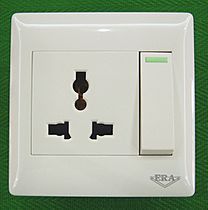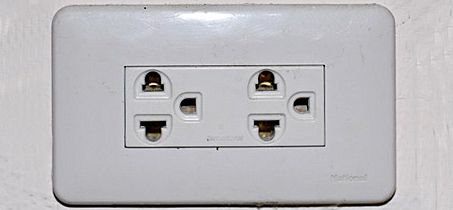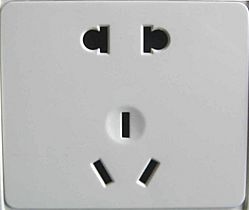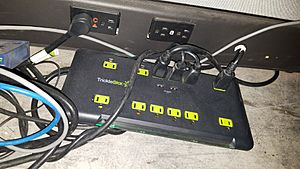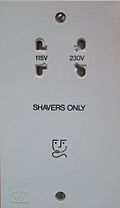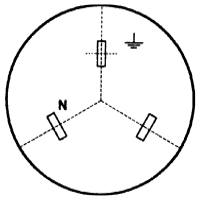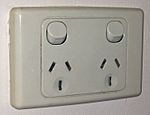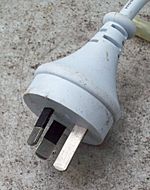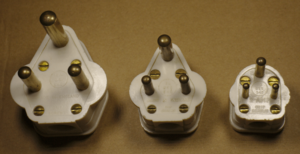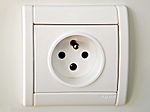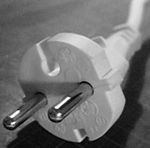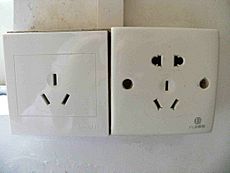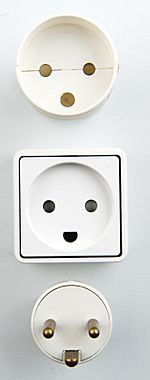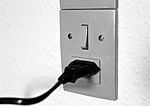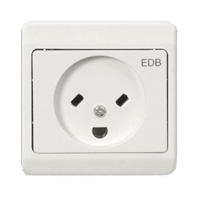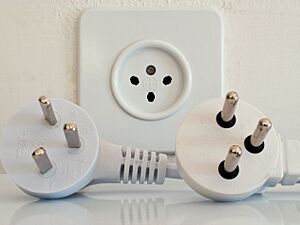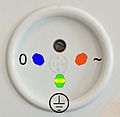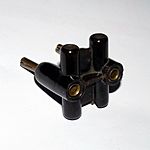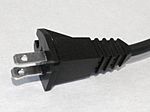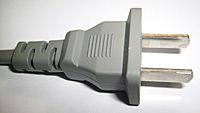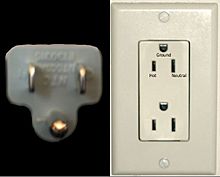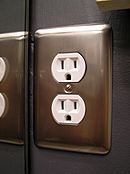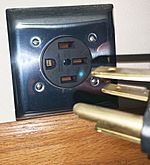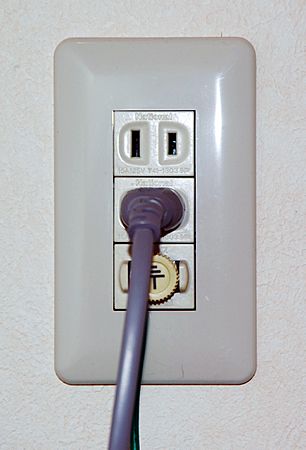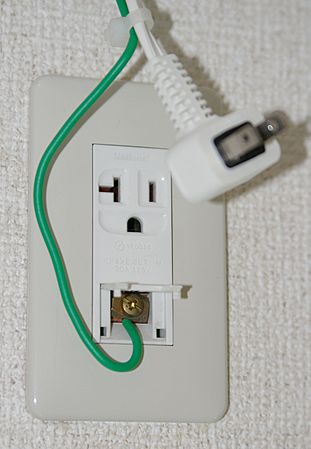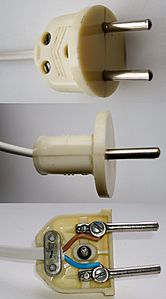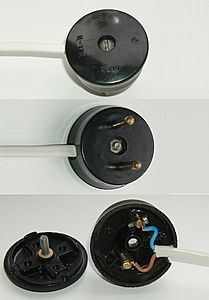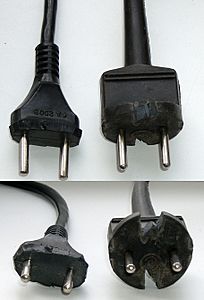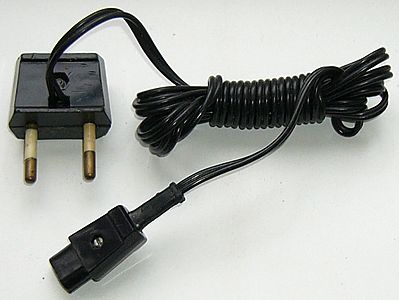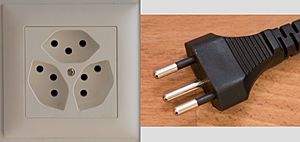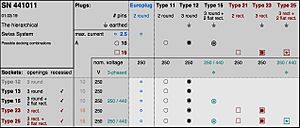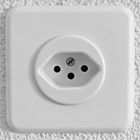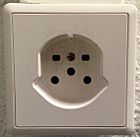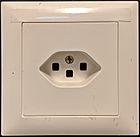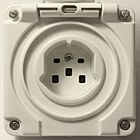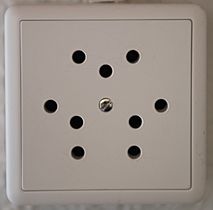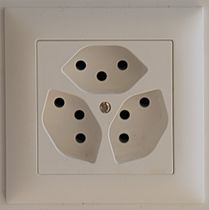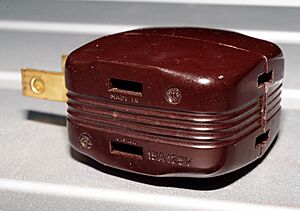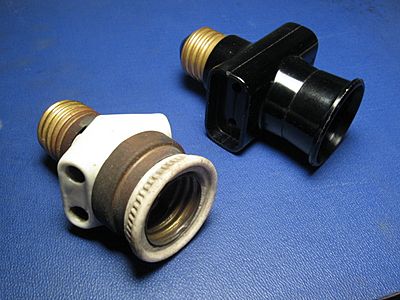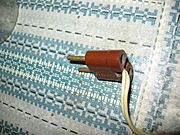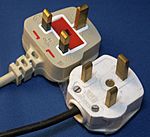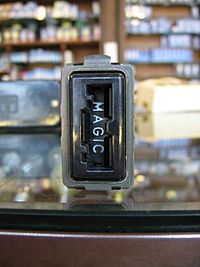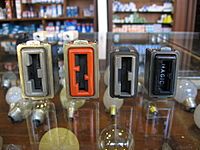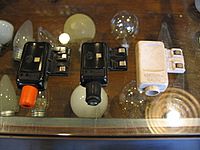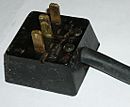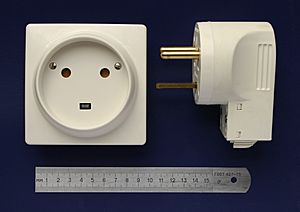AC power plugs and sockets facts for kids
AC power plugs and sockets are devices that connect your electric equipment to the main alternating current (AC) power supply in buildings. Think of them as the special connectors that let you plug in your phone charger, TV, or computer!
These plugs and sockets come in many different shapes, sizes, and designs. They also handle different amounts of voltage (how strong the electricity is) and current (how much electricity flows). Because of this, different countries around the world use different types of plugs and sockets.
Plugs and sockets for things like lamps and fans first appeared in the 1880s. Before that, people often had to connect their appliances directly to light bulb sockets! Over time, many different types were created to make them safer and easier to use. Today, there are about 20 common types used worldwide. Thanks to shared technical standards, some plugs can be used in large areas, making it easier to buy and use electronics from different places.
Sometimes, you might see "multi-standard" sockets that can fit several types of plugs. However, using unofficial adapters or universal sockets might not be as safe as using the correct plug and socket combination.
Contents
- What are Plugs and Sockets?
- A Quick Look at History
- Safety Features and Issues
- Types of Plugs and Sockets Used Today
- Argentina (Type I)
- Australia and New Zealand (Type I)
- Brazil (Type N)
- British and Related Standards
- CEE 7 Standard (Europe)
- China (Type A & I)
- Danish (Type K)
- IEC 60906-1 (Type N)
- Israel SI32 (Type H)
- Italy (Type L)
- North America, Central America and IEC 60906-2
- Soviet Standard GOST 7396 C 1 Unearthed
- Swiss SN 441011 (Type J)
- Thai Three-Pin Plug TIS 166-2549 (Type O)
- Comparison of Standard Types
- Adaptors
- Unusual Types
- Single Phase Electric Stove Plugs and Sockets
- See Also
What are Plugs and Sockets?
A plug is the part that moves. It's attached to your electronic device, like a laptop charger. The plug usually has pins that stick out. These are called "male" connectors.
A socket is fixed to a wall or a piece of equipment. It's connected to the building's electrical wires. The socket has holes or slots that match the plug's pins. These are called "female" contacts.
Some plugs have a special pin just for earth ground. This is a safety feature. Some plugs also have fuses inside to protect against too much electricity.
To keep you safe from electric shock, plugs and sockets have special designs. For example, the holes in sockets are often deep so you can't easily touch the live parts.
Most common sockets have two connections for electricity. They might also have a third connection for safety, called an earth ground.
A Quick Look at History
When electricity first became available in the 1880s, it was mainly used for lights. People would plug other appliances, like fans or irons, into light bulb sockets!
By 1885, a two-pin plug and wall socket were available in Britain. Around 1910, the first three-pin plugs with an earth connection (for safety) started to appear. Over the years, more safety features were added. The first official standard for plugs and sockets was set in 1915.
Safety Features and Issues
Protection from Accidental Contact
Plug and socket designs have improved over time to prevent electric shocks and fires.
- Plugs are shaped so your fingers can't easily touch the live parts.
- Sockets might be recessed (set back) so the plug fits snugly, reducing the chance of touching live pins.
- Some plug pins have insulation sleeves. This means that if you pull the plug out slowly, the metal part that carries electricity is covered, keeping you safe.
- Sockets can have automatic shutters. These are like tiny doors that block the holes until a plug is fully inserted. This stops foreign objects (like paper clips) from being put into the live contacts.
- Some plugs and sockets also have built-in fuses or switches for extra safety.
Earthing (Grounding)
Many plugs and sockets have a third connection called an earth (or ground) pin. This pin is super important for safety!
- It protects you if there's a problem with the electrical insulation inside an appliance.
- The earth pin is often designed to connect to the socket *before* the other pins. This makes sure the appliance is grounded even if it's not fully plugged in.
- Appliances are sorted into classes based on their need for earthing. Class I equipment needs an earth connection, while Class II equipment has "double insulation" for safety without an earth pin.
Polarisation
Some electrical systems have a "neutral" wire. When a plug is "polarised," it means it can only be plugged into the socket one way.
- This helps keep the electrical connections consistent inside the appliance.
- For example, it can make sure that switches always turn off the "live" side of the circuit, which is safer.
- Not all wiring systems use polarisation, especially if both wires carry significant voltage compared to the earth.
Universal Sockets
"Universal" or "multi-standard" sockets are designed to fit many different types of plugs.
- However, in some places, these sockets don't meet safety standards.
- Safety experts warn that universal sockets and adapters can have problems. These include voltage mismatches, exposed live pins, or a lack of proper earth grounding.
- They might also not be strong enough or handle heat well, as they often don't follow official technical standards.
Voltage Rating of Plugs and Cords
Plugs and power cords have a specific voltage and current rating from the manufacturer.
- Using a plug or cord that isn't right for the amount of power needed can be dangerous and even cause a fire.
- For example, a device that uses a lot of current should not be plugged into a thin extension cord meant for low-power items.
- Travelers should always check that their power cords are rated for the correct voltage in the country they are visiting.
Appliance Connections and Extensions
To make things easier, many appliances have a special IEC 60320 inlet. This means you can use a detachable power cord with the right plug for your country.
- This way, manufacturers don't have to make many different versions of the same appliance.
- Some appliances also have a switch to select the correct voltage.
Extension cords are useful when a socket isn't close enough. A power strip can have multiple sockets and might also include a switch, surge protection, or protection against too much current.
Special Purpose Plugs and Sockets
Some buildings have special sockets for specific uses:
- "Clean" earth sockets for sensitive computer systems.
- Sockets for emergency power supply.
- Sockets for Uninterruptible power supply (UPS) for important medical equipment.
- Isolated power sockets for medical tools or tools used in wet places.
- Special sockets for theatrical lighting.
- IEC 60309 (CEE 17) plugs are weather-resistant connectors. They are used for caravans, Motorhomes, and camper vans at camp-sites.
- Sockets for electric clothes dryers, ovens, and air conditioners. These need higher current ratings.
These special sockets might be colored or labeled. They might also have unique shapes to prevent people from plugging in the wrong equipment.
Shaver Supply Units
In some countries, it's not allowed to have regular sockets too close to water taps. So, special shaver sockets are used near sinks.
- These sockets have an isolation transformer inside. This transformer makes them safer to use near water.
- However, these sockets are only for low-power devices like electric razors. They can't handle high-power appliances like hair dryers.
- Shaver sockets can often accept different two-pin plugs, like the Europlug (Type C) and the Australian (Type I) plug. Some also accept US Type A plugs.
- They are usually marked with a shaver symbol and might say "shavers only."
Types of Plugs and Sockets Used Today
Governments in different areas decide which plugs and sockets can be used.
The International Electrotechnical Commission (IEC) has a guide that uses letters (like Type A, Type B) to help identify compatible plugs. This guide is helpful for travelers. However, a letter doesn't always mean a plug is perfectly compatible, as there can be different versions or voltage requirements.
In Europe, CENELEC lists the approved plug and socket standards for its member countries.
Argentina (Type I)
Argentina uses a plug and socket system defined by IRAM standards.
- It looks similar to Australian and Chinese plugs.
- It has an earth pin and two flat pins that form an upside-down V-shape.
- The main difference from the Australian plug is that the live and neutral wires are reversed in the Argentinian plug.
Australia and New Zealand (Type I)
This standard is used in Australia, New Zealand, Fiji, and other nearby islands.
- The plug has an earth pin and two flat pins that form an upside-down V-shape.
- Australian and New Zealand wall sockets usually have switches for extra safety.
- There are different versions of this plug for devices that use more current (like 15A, 20A). Sockets can accept plugs of the same or lower current rating, but not higher.
- Since 2004, plugs must have insulated pins to prevent shocks.
Brazil (Type N)
Brazil adopted a new national standard in 1998, called NBR 14136.
- This standard is similar to the IEC 60906-1 design.
- There are two types: one for 10A (with 4.0mm pins) and another for 20A (with 4.8mm pins).
- Even though Brazil uses 220V and 127V electricity, the standard is meant for both.
- Many older homes in Brazil don't have an earthed supply, so even with a three-pin socket, the earth might not be connected. The new standard aims to fix this.
British and Related Standards
BS 546 (Type D and M)
This standard describes four sizes of plugs (2A, 5A, 15A, and 30A).
- The plugs have three round pins arranged in a triangle. The largest top pin is for earthing.
- These plugs are polarised (can only be plugged in one way) and do not have fuses built-in.
- The BS 546 type has mostly been replaced in the UK by the BS 1363 standard.
- However, about 40 countries still use Type D (5A) and 15 countries use Type M (15A), often based on BS 546.
BS 1363 (Type G)
This is the main plug and socket type used in the United Kingdom.
- It's also used in over 50 other countries, including Ireland, Malaysia, and Singapore.
- This plug has three rectangular pins that form a triangle.
- The BS 1363 plug has a fuse inside. This fuse protects the appliance's cord from getting too hot and causing a fire.
- New appliances usually come with the correct fuse already installed.
BS 4573 (UK Shaver)
The UK, Ireland, and Malta use this two-pin plug and socket specifically for electric shavers and toothbrushes.
- The plug pins have insulated sleeves for safety.
- It looks similar to the Europlug (Type C), but the pins are slightly different, so it won't fit into a Schuko socket.
- However, some sockets and adapters can accept both BS 4573 and Europlugs.
CEE 7 Standard (Europe)
The CEE 7 standard covers many plugs and sockets used in Europe. Most of these have two round pins spaced 19mm apart.
- Each country in the EU has its own rules and standards. For example, some require child-resistant shutters on sockets, while others don't.
CEE 7/1 Socket and CEE 7/2 Plug (Unearthed)
- These sockets accept round plugs with 4.8mm pins.
- They don't have an earth connection, so they are being phased out in most countries.
- Older sockets were sometimes shallow, making it possible to accidentally touch live pins.
CEE 7/3 Socket and CEE 7/4 Plug (German "Schuko"; Type F)
The CEE 7/3 socket and CEE 7/4 plug are often called Schuko. This means "protective contact" in German.
- The socket has a round shape with two round holes and two earthing clips. These clips connect before the live pins touch, adding safety.
- The pins are 4.8mm thick.
- The Schuko system is not polarised, meaning you can plug it in either way.
- It's rated for 16A.
- This standard is used in Germany and many other European, Asian, and African countries. Some countries require child-proof shutters, but the German standard doesn't.
CEE 7/5 Socket and CEE 7/6 Plug (French; Type E)
The French standard defines the CEE 7/5 socket and CEE 7/6 plug.
- The socket has a round recess with two round holes and a projecting earth pin. This earth pin connects before the live contacts.
- The plug has two round pins (4.8mm thick) and a hole for the socket's earth pin.
- This standard is also used in Belgium, Poland, and the Czech Republic.
- Even though the plug is polarised, there's no universal rule for which way the live and neutral wires are connected.
CEE 7/7 Plug (Compatible with E and F)
This plug is designed to fit both French (CEE 7/5) and Schuko (CEE 7/3) sockets.
- It has earthing contacts that work with either type of socket.
- It's polarised when used with a French socket, but can be inserted two ways into a Schuko socket.
- This plug is rated for 16A. Many appliances come with this non-rewirable plug.
CEE 7/16 Plugs
The CEE 7/16 plug is used for appliances that don't need an earth connection. It has two round pins (4mm by 19mm) and is rated for 2.5A. There are two versions:
CEE 7/16 Alternative II "Europlug" (Type C)
The Europlug is a flat, 2.5A-rated plug.
- It's not rewirable and comes attached to a flexible cord.
- It can be inserted in either direction, so the live and neutral connections are arbitrary.
- The pins are slightly flexible to make better contact.
- There isn't a specific socket just for the Europlug. Instead, it fits into many common European sockets, including CEE 7/1, CEE 7/3 (Schuko), and CEE 7/5 (French) sockets.
- It's also used in parts of the Middle East, Africa, South America, and Asia.
CEE 7/17 Unearthed Plug
This is a round plug that fits CEE 7/1, CEE 7/3, and CEE 7/5 sockets.
- It has two round pins (4.8mm by 19mm). Unlike the Europlug, these pins are not insulated.
- It's rated for 10A or 16A.
- It's often used for Class II appliances (which don't need an earth connection) that use more than 2.5A.
- It's sometimes called a "contour plug" because its shape fits the socket's recess, preventing accidental contact with the pins.
China (Type A & I)
China's plugs and sockets (excluding Hong Kong and Macau) follow GB standards.
- The main plug is a three-wire, earthed type, rated for 10A, 250V. A larger 16A version also exists.
- It's similar to the Australian plug.
- Many Chinese 3-pin sockets have a safety lock. This prevents access to the live and neutral terminals unless the earth pin (which is slightly longer) is inserted first.
- China also uses American/Japanese NEMA 1-15 sockets for Class II appliances. A common socket type also accepts Europlugs (Type C).
- The voltage in China is 220V.
Danish (Type K)
The Danish standard plug is described in the Danish Plug Equipment Section 107-2-D1.
- Danish sockets are designed to have child-resistant shutters.
- The Danish socket can also accept the CEE 7/16 Europlug or CEE 7/7 Schuko-French hybrid plug.
- However, CEE 7/4 (Schuko) and CEE 7/6 (French) plugs will fit but won't provide an earth connection.
- Since 2008, all new electrical installations in Denmark must have earthed sockets. Older sockets must be protected by earth-fault interrupters.
IEC 60906-1 (Type N)
In 1986, the IEC published this standard for a plug and socket. It was meant to become common across Europe and other 230V regions, but this didn't happen.
- The plug and socket are rated for 16A, 250V AC.
- The plug pins are 4.5mm in diameter. The earth pin is slightly offset.
- Shutters over the live and neutral pins are required for safety.
- South Africa is the only country to officially adopt this standard (as SANS 164-2).
- Brazil developed a similar plug (NBR 14136), but it doesn't fully comply with IEC 60906-1.
Israel SI32 (Type H)
This plug is used only in Israel and in the West Bank and Gaza Strip.
- There's an older version with flat pins and a newer one with round pins.
- The pre-1989 system had three flat pins in a Y-shape.
- In 1989, the standard was updated to use three round 4.5mm pins in the same locations. This allows sockets to accept both older and newer Israeli plugs, as well as non-earthed Europlugs.
- Older sockets that only accept flat-pin plugs are now very rare.
- SI 32 plugs don't have insulation sleeves on their pins. This means if a plug is partly removed, the pins could still be live and touched, which is a shock hazard.
Italy (Type L)
Italian plugs and sockets are defined by the CEI 23-50 standard.
- There are two main types: 10A and 16A. They have different pin diameters and spacing.
- Both types are symmetrical, so you can plug them in either way.
- This plug is also commonly used in Chile and Uruguay.
- The 10A plugs have 4mm diameter pins, spaced 19mm apart.
- The 16A plugs have 5mm diameter pins, spaced 26mm apart.
- Italian sockets often have child-resistant shutters.
Italian Multiple Standard Sockets
In Italy, it's common to find sockets that can accept more than one standard plug type.
- The simplest type, called CEI 23-50 P 17/11 (or Bipasso), has holes that fit both 10A and 16A Italian plugs, as well as Europlugs.
- Another common type, CEI 23-50 P 30, looks like a Schuko socket but also has a central earthing hole. This can accept German, French, and Europlugs, plus 10A Italian plugs.
- Even more versatile sockets exist, like the CEI 23-50 P 40, which accepts a wide range of European and Italian plugs.
North America, Central America and IEC 60906-2
Most of North and Central America use connectors standardized by the National Electrical Manufacturers Association (NEMA).
- NEMA devices are named like NEMA n-mmX, where 'n' is the pin configuration, 'mm' is the max current, and 'X' is P for plug or R for receptacle (socket).
- Different pin arrangements prevent plugging a high-current device into a low-current socket.
NEMA 1-15 Ungrounded (Type A)
- These plugs have two parallel blades and are rated for 15A at 125 volts.
- They don't have a ground connection.
- Older versions were not polarised, but most modern ones are, with one wider blade for the neutral wire.
- Ungrounded NEMA-1 outlets are not allowed in new buildings in the US and Canada, but you might still find them in older ones.
NEMA 5-15 Grounded (Type B)
- The NEMA 5-15 plug has two flat parallel blades and a ground (earth) pin.
- It's rated for 15A at 125 volts.
- The ground pin is longer than the other two. This means it connects to the ground before the power pins, which is a safety feature.
- This socket is recommended for 120-volt installations.
- Some safety guidelines suggest mounting sockets with the ground hole up.
- New homes might require "tamper-resistant" sockets with shutters to prevent objects from being inserted.
NEMA 5-20
- The NEMA 5-20 plug has blades that are perpendicular to each other.
- The socket has a T-shaped slot for the neutral blade. This allows it to accept both 15A parallel-blade plugs and 20A plugs.
NEMA 14-50
- NEMA 14-50 sockets are often found in RV parks for connecting large recreational vehicles.
- They are also used for high-power appliances like electric car chargers.
Other NEMA Types
- 30-amp and 50-amp rated sockets are used for appliances that need a lot of current, like clothes dryers and electric stoves.
JIS C 8303, Class II Ungrounded (Japan)
- Japanese Class II plugs and sockets look like NEMA 1-15 and are rated for 15A.
- However, the Japanese Industrial Standard (JIS C 8303) has stricter rules for their size and testing.
- Older Japanese sockets are unpolarised, meaning both slots are the same size.
- In Japan, the voltage is 100V. The frequency is either 50Hz (East Japan) or 60Hz (West Japan). This means some North American devices might not work correctly even if they fit.
JIS C 8303, Class I Earthed (Japan)
- Japan also uses a grounded plug similar to the North American NEMA 5-15, but it's less common.
- Since 2005, new Japanese homes must have Class I grounded sockets for domestic appliances.
Soviet Standard GOST 7396 C 1 Unearthed
This Soviet plug is still sometimes used.
- Its pins are the same size and spacing as the Europlug, but it doesn't have insulation sleeves.
- It's rated for 6A.
- It can have a round body (like CEE 7/2) or a flat body with a round base (like CEE 7/17).
- The pins are parallel and don't get closer together.
- The matching 6A socket accepts the Europlug.
Swiss SN 441011 (Type J)
The Swiss standard, also used in Liechtenstein, is SN 441011.
- It's a system with two, three, and five pins, rated at 10A or 16A.
- Sockets can accept plugs with the same or fewer pins, and the same or lower ratings.
- The standard also includes three-phase plugs for higher power.
- Swiss standards do not require child protective shutters.
10A Plugs and Sockets (Type J)
- The Type 11 plug is unearthed, with two 4mm round pins spaced 19mm apart.
- The Type 12 plug adds a central 4mm round earth pin.
- Type 12 and Type 13 sockets accept both Type 11 and Type 12 plugs, and also the 2.5A Europlug.
- Older Type 11 and 12 plugs didn't have insulated pins, which could be a shock hazard if partly inserted.
- The IEC Type J refers to the Swiss Type 12 plugs and Type 13 sockets.
- Switzerland also has a unique three-phase socket (Type 15) that can accept single-phase plugs.
16A Plugs and Sockets
- These are similar to the 10A types but have 4mm x 5mm rectangular pins instead of round ones.
- The sockets can still accept the 10A plugs.
- The unearthed Type 21 plug has two rectangular pins. The Type 23 plug adds a central rectangular earth pin.
- The recessed Type 23 socket accepts various 10A and 16A plugs, plus the Europlug.
- There's also a three-phase Type 25 socket that accepts many single-phase plugs.
Pictures
- Other Swiss socket forms
Thai Three-Pin Plug TIS 166-2549 (Type O)
Thailand updated its standards to TIS 166-2549 because it uses 220V electricity.
- The plug has two round power pins (4.8mm diameter, 19mm long) and an earth pin (same diameter, 21.4mm long).
- The earth pin's spacing allows it to fit older hybrid sockets that accepted NEMA 1-15, NEMA 5-15, and Europlugs.
- Thai sockets are polarised.
- This plug is similar to the Israeli SI32 plug but they are not interchangeable.
- The Thai plug is called "Type O" by IEC World Plugs.
Comparison of Standard Types
| IEC TR 60083 World Plugs Type |
Standard | Origin | Rating | Earthed (grounded) |
Polarised | Fused | Insulated pins |
Socket accepts Europlug |
|
|---|---|---|---|---|---|---|---|---|---|
| A | NEMA 1-15 unpolarised | American | 15 A | 125 V | No | No | No | No | No |
| NEMA 1-15 polarised | American | 15 A | 125 V | No | Yes | No | No | No | |
| JIS C 8303, Class II | Japanese | 15 A | 100 V | No | Optional | No | No | No | |
| B | NEMA 5-15 | American | 15 A | 125 V | Yes | Yes | No | No | No |
| JIS C 8303, Class I | Japanese | 15 A | 100 V | Yes | Yes | No | No | No | |
| C | CEE 7/16 | Europlug | 2.5 A | 250 V | No | No | No | Yes | N/A |
| N/A | CEE 7/17 plug | French / German hybrid |
16 A | 250 V | No | No | No | No | N/A |
| N/A | CEE 7/1 socket & CEE 7/2 plug | N/A | 16 A 10 A |
250 V | No | No | No | No | Yes |
| N/A | GOST 7396 C 1 | Soviet / Russian |
16 A 6 A |
250 V | No | No | No | No | Yes |
| N/A | BS 4573 | British | 0.2 A | 250 V | No | No | No | Yes | No |
| Socket only; plug is unspecified | |||||||||
| D | BS 546 | British | 5 A | 250 V | Yes | Yes | Optional | Optional | No |
| IS 1293:2005 | Indian | 6 A | 250 V | Yes | Yes | Optional | Optional | No | |
| SANS 164-3 | South African | 5 A | 250 V | Yes | Yes | Optional | Optional | No | |
| E | CEE 7/5 socket & CEE 7/6 plug | French | 16 A | 250 V | Yes | Partially | No | No | Yes |
| F | CEE 7/3 socket & CEE 7/4 plug | German "Schuko" |
16 A | 250 V | Yes | No | No | No | Yes |
| N/A | CEE 7/7 plug | French / German hybrid |
16 A | 250 V | Yes | No | No | No | N/A |
| G | BS 1363, IS 401 & IS 411, MS 589, SS 145 | British | 13 A 3 A |
250 V | Yes | Yes | Yes | Yes | Not safely |
| H | SI 32 | Israeli | 16 A 10 A |
250 V | Yes | Yes | No | No | Yes |
| I | AS/NZS 3112 | Australian and New Zealander |
15 A 10 A |
250 V | Yes | Yes | No | Yes | No |
| GB 1002 and GB 2099.1 |
Chinese | 10 A | 250 V | Yes | Yes | No | No | No | |
| IRAM 2073 | Argentinian | 10 A | 250 V | Yes | Yes | No | No | No | |
| J | SEV 1011:2009, Typ 12 plug and Typ 13 socket | Swiss | 10 A | 250 V | Yes | Yes | No | Yes | Yes |
| K | 107-2-D1 | Danish | 13 A | 250 V | Yes | Yes | No | No | Yes |
| L | CEI 23-50 (formerly CEI 23-16) | Italian | 10 A | 250 V | Yes | No | No | Yes | Yes |
| CEI 23-50 (formerly CEI 23-16) | Italian | 16 A | 250 V | Yes | No | No | Yes | No | |
| M | BS 546 | British | 15 A | 250 V | Yes | Yes | Optional | Optional | No |
| IS 1293:2005 | Indian | 16 A | 250 V | Yes | Yes | Optional | Optional | No | |
| SANS 164-1 | South African | 16 A | 250 V | Yes | Yes | Optional | Optional | No | |
| N | NBR 14136 2-pin | Brazilian | 20 A 10 A |
250 V | No | No | No | Yes | Yes |
| NBR 14136 3-pin | Brazilian | 20 A 10 A |
250 V | Yes | Yes | No | Yes | Yes | |
| SANS 164-2 2-pin | South African | 16 A | 250 V | No | No | No | Yes | Yes | |
| SANS 164-2 3-pin | South African | 16 A | 250 V | Yes | Yes | No | Yes | Yes | |
| O | TIS 166-2549 | Thai | 16 A | 250 V | Yes | Yes | No | Yes | Yes |
| IEC World Plugs Type |
Standard | Origin | Rating | Earthed | Polarised | Fused | Insulated pins |
Socket accepts Europlug |
|
Adaptors
Travel Adaptors
Travel adaptors let you plug your devices into sockets in other countries.
- However, these adaptors usually don't change the voltage or frequency of the electricity.
- If the voltage is different, you might need a voltage converter to protect your device.
- Always check the voltage and frequency requirements of your devices when traveling!
Multisocket Adaptors
Multisocket adaptors let you plug two or more devices into a single wall socket.
- They come in different shapes and sizes, depending on the country.
- These are often used for low-power devices like TVs or lamps.
- They have a maximum total current rating. For example, if an adaptor is rated for 16A, the total current from all devices plugged into it should not go over 16A.
- In some countries, these adaptors are not allowed because they can cause fires if overloaded.
Unusual Types
Lampholder Plug
A lampholder plug fits into a light socket, letting you plug in other appliances.
- In the past, electricity for lighting was sometimes cheaper. These plugs let people use other appliances on the cheaper lighting circuit.
- They are rarely fused, which means they don't have built-in protection.
- Edison screw lampholder adaptors are still used in the Americas.
Soviet Adaptor Plugs
Some appliances in the Soviet Union had a flat, unearthed plug with an extra socket on top. This allowed people to stack plugs.
- This was useful because many Soviet apartments had very few sockets.
- However, this design was somewhat unsafe. The metal parts of the secondary socket were exposed, and the connection wasn't always good.
- These adaptors were mostly used for low-power devices like lamps and radios.
UK Walsall Gauge Plug
This plug is different from the standard UK BS 1363 plug.
- The earth pin is horizontal, and the live and neutral pins are vertical.
- This type of plug was used in university labs, by the BBC, and is still used on parts of the London Underground for 110V AC.
- It was also used in some government buildings to prevent staff from plugging in unauthorized devices.
Italian BTicino Magic Security Connector
In the 1960s, the Italian company BTicino introduced these "Magic Security" connectors.
- The socket is rectangular with special "key" pins to ensure correct plugging and prevent mismatching current ratings.
- It came in 10A, 16A, and 20A versions, plus a three-phase industrial type.
- The socket has a safety lid that only opens when even pressure is applied, stopping objects from being inserted.
- The plug's contacts only become live when fully inserted.
- This system wasn't compatible with standard Italian plugs or Europlugs. Appliances weren't sold with these plugs, so people had to cut off the original plug and replace it.
- Even though it was safer, it became less popular when similar safety lids were developed for standard sockets.
- In Chile, 10A Magic connectors are still used for computer and lab power networks. This helps prevent people from plugging sensitive equipment into unprotected lines.
Single Phase Electric Stove Plugs and Sockets
Electric stoves need a lot of power. If they aren't wired directly into the wall, they use special high-power plugs and sockets.
- These plugs and sockets must be rated for higher current than regular ones.
- In Russia, electric stoves often use 25A or 32A connectors.
- In Norway and parts of Sweden, a 25A grounded connector with a rectangular shape is used for single-phase stoves. It has three rectangular pins in a row, with the grounding pin being longer.
See Also
 In Spanish: Enchufe para niños
In Spanish: Enchufe para niños
- DC connector
- History of AC power plugs and sockets
- IEC 60309 high-power industrial and polyphase connectors
- IEC 60320 appliance connectors
- Industrial and multiphase power plugs and sockets
- Mains electricity
- Mains electricity by country lists voltage, frequency, and connector types for over 200 countries
- Perilex
- Plug load
- Polyphase system
- Smart plug
- Stage pin connector
- Anderson Powerpole




